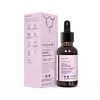What's inside
What's inside
 Key Ingredients
Key Ingredients

 Benefits
Benefits

 Concerns
Concerns

No concerns
 Ingredients Side-by-side
Ingredients Side-by-side

Water
Skin ConditioningAzelaic Acid 10%
BufferingPropylene Glycol
HumectantGlycerin
HumectantTranexamic Acid 2%
AstringentNiacinamide
SmoothingAmmonium Acryloyldimethyltaurate/Vp Copolymer
Caprylic/Capric Triglyceride
MaskingLactobacillus/Punica Granatum Fruit Ferment Extract
Skin ConditioningSqualane
EmollientPhenoxyethanol
PreservativeAllantoin
Skin ConditioningEthylhexylglycerin
Skin ConditioningFlavobacterium Thermophilum Ferment Filtrate Lysate
Skin ConditioningSaccharomyces/Xylinum/Black Tea Ferment
Skin ConditioningHydroxyethylcellulose
Emulsion StabilisingAlgin
MaskingGlycyrrhiza Glabra Root Extract
BleachingCamellia Sinensis Leaf Extract
AntimicrobialArnica Montana Extract
Skin ConditioningWater, Azelaic Acid 10%, Propylene Glycol, Glycerin, Tranexamic Acid 2%, Niacinamide, Ammonium Acryloyldimethyltaurate/Vp Copolymer, Caprylic/Capric Triglyceride, Lactobacillus/Punica Granatum Fruit Ferment Extract, Squalane, Phenoxyethanol, Allantoin, Ethylhexylglycerin, Flavobacterium Thermophilum Ferment Filtrate Lysate, Saccharomyces/Xylinum/Black Tea Ferment, Hydroxyethylcellulose, Algin, Glycyrrhiza Glabra Root Extract, Camellia Sinensis Leaf Extract, Arnica Montana Extract
Water
Skin ConditioningPotassium Azeloyl Diglycinate
Skin ConditioningDimethyl Isosorbide
SolventEthoxydiglycol
HumectantPropanediol
SolventZinc PCA
HumectantPhenoxyethanol
PreservativeEthylhexylglycerin
Skin ConditioningHydroxyethylcellulose
Emulsion StabilisingBetaine
HumectantAloe Barbadensis Leaf Extract
Emollient1,2-Hexanediol
Skin ConditioningXanthan Gum
EmulsifyingLactic Acid
BufferingSodium Gluconate
Skin ConditioningCitrullus Lanatus Fruit Extract
Skin ConditioningPassiflora Edulis Fruit Extract
Skin ConditioningCamellia Sinensis Leaf Extract
AntimicrobialPyrus Malus Fruit Extract
Skin ConditioningCurcuma Longa Root Extract
MaskingWater, Potassium Azeloyl Diglycinate, Dimethyl Isosorbide, Ethoxydiglycol, Propanediol, Zinc PCA, Phenoxyethanol, Ethylhexylglycerin, Hydroxyethylcellulose, Betaine, Aloe Barbadensis Leaf Extract, 1,2-Hexanediol, Xanthan Gum, Lactic Acid, Sodium Gluconate, Citrullus Lanatus Fruit Extract, Passiflora Edulis Fruit Extract, Camellia Sinensis Leaf Extract, Pyrus Malus Fruit Extract, Curcuma Longa Root Extract
Ingredients Explained
These ingredients are found in both products.
Ingredients higher up in an ingredient list are typically present in a larger amount.
Camellia Sinensis Leaf Extract is derived from the leaves of the tea plant. Black tea, green tea, and oolong tea are all harvested from this plant.
This ingredient has many skin benefits:
This ingredient contains polyphenols, a strong antioxidant. Antioxidants help fight off molecules that damage skin cells.
On top of that, the antioxidants in green tea neutralize free-radicals from the sun. This gives the skin some extra UV protection, but should not replace sunscreen.
Many components of tea have anti-inflammatory properties.
Polyphenols and L-theanine help soothe the skin and reduce irritation. The caffeine in Camellia Sinensis Leaf Extract helps calm inflamed blood vessels.
Other compounds found in tea include: Vitamin Bs, linoleic acid, magnesium, calcium, iron, and zinc.
Research has shown both drinking Camellia Sinensis Leaf Tea and applying it to the skin can help boost skin elasticity and hydration. Studies also show using tea extract may reduce sebum, or oil, production.
Learn more about Camellia Sinensis Leaf ExtractEthylhexylglycerin (we can't pronounce this either) is commonly used as a preservative and skin softener. It is derived from glyceryl.
You might see Ethylhexylglycerin often paired with other preservatives such as phenoxyethanol. Ethylhexylglycerin has been found to increase the effectiveness of these other preservatives.
Hydroxyethylcellulose is used to improve the texture of products. It is created from a chemical reaction involving ethylene oxide and alkali-cellulose. Cellulose is a sugar found in plant cell walls and help give plants structure.
This ingredient helps stabilize products by preventing ingredients from separating. It can also help thicken the texture of a product.
This ingredient can also be found in pill medicines to help our bodies digest other ingredients.
Learn more about HydroxyethylcellulosePhenoxyethanol is a preservative that has germicide, antimicrobial, and aromatic properties. Studies show that phenoxyethanol can prevent microbial growth. By itself, it has a scent that is similar to that of a rose.
It's often used in formulations along with Caprylyl Glycol to preserve the shelf life of products.
Water. It's the most common cosmetic ingredient of all. You'll usually see it at the top of ingredient lists, meaning that it makes up the largest part of the product.
So why is it so popular? Water most often acts as a solvent - this means that it helps dissolve other ingredients into the formulation.
You'll also recognize water as that liquid we all need to stay alive. If you see this, drink a glass of water. Stay hydrated!
Learn more about Water